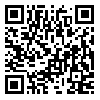BibTeX | RIS | EndNote | Medlars | ProCite | Reference Manager | RefWorks
Send citation to:
URL: http://3dj.gums.ac.ir/article-1-26-fa.html
Introduction:Temporomandibular disorders (TMDs) are referred to signs and symptoms involving masticatory muscles, temporomandibular joint and relevant structures. Having been prevalent noticeably, we decided to evaluate the frequency of TMD, among patients referred to the dental clinic of Guilan university of medical sciences. Materials and Methods: In this cross-sectional study, a sample of 265 subjects with the age range of 15-62 was randomly selected. Signs and symptoms of TMD and different types of malocclusion including anterior open bite, deep bite, edge to edge, overjet more than 4mm, midline deviation, posterior unilateral and bilateral cross bite, crowding, posterior teeth loss, premature contact in retruded contact position, lateral excursion and protrusion, tooth wear and bruxism were examined. Data were analyzed statistically using Chi-square and Fisher’s Exact Test. Results: The prevalence of TMD was 53.2%.The frequency of symptoms was 20.3% joint sound, 12.8% facial or joint pain, 3.4% headache, 5.3% limited mouth opening, 0.7% closed lock, 1.9% open lock.The frequency of signs was 10.1% limitation in mouth opening, 7.1% limitation in protrusion, 7.9%, limitation in lateral excursion and 37.5% deviation in jaw opening, 11.3% pain during jaw movements, 3.3% tenderness of joint, 35.8% joint sound, 16.2% muscle tenderness. A significant relationship was observed between bruxism, being female, tooth wear, premature contact in lateral movement at balancing side and TMD. Conclusion: TMDs are prevalent in Guilan province and more frequent among ages 20-25 years.There is a higher risk in people with bruxism, tooth wear, and premature contact at balancing side in lateral excursion as well as females to develop TMD.
| بازنشر اطلاعات | |
 | این مقاله تحت شرایط Creative Commons Attribution-NonCommercial 4.0 International License قابل بازنشر است. |


